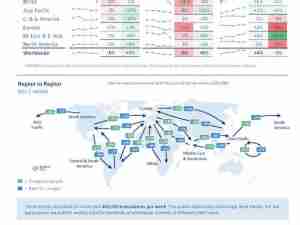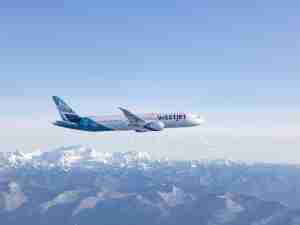Fitch Affirms Niagara Frontier Transportation Auth’s Airport Rev Bonds at ‘BBB+’; Outlook Stable
posted by AJOT | Oct 17 2016 at 10:36 AM | Air Cargo
Fitch Ratings has affirmed Niagara Frontier Transportation Authority, NY's (NFTA) approximately $70.8 million of series 2014A&B airport revenue refunding bonds at 'BBB+'. The Rating Outlook is Stable.
KEY RATING DRIVERS
The rating reflects Buffalo Niagara International Airport's (BNIA) historically stable enplanement base with dependency on Canadian cross-border air travelers, low debt burden and manageable near-term capital investment needs. The airport's financial metrics are favorable to other airports in the rating category. However, the airport has the ability and ongoing history of making subsidy transfers to support other authority transportation operations including the Metro Transit System and the Niagara Falls International Airport (NFIA), which limits the airport's ability to build liquidity as growing deficits of NFIA can drain the Airport Development Fund (ADF). BNIA remains weaker relative to its peer Albany due to some exposure to competition from surrounding airports and exchange rate risk.
Revenue Risk: Volume - Midrange
O&D Airport with Exposure to Canadian Traffic:
BNIA is a medium hub airport with an origination and destination (O&D) enplanement base of 2.32 million in fiscal year (FY) 2016. The airport's proximity to the Canadian border and particular fare pricing advantages provided by the airport allows it to capture a significant amount of Canadian traffic, which the airport estimates to be approximately 40% of locally originating passengers. The airport is served by a diverse set of low-cost and national carriers with no one airline exceeding more than 35% of enplanement in FY2016. Toronto's main airport and to a lesser extent nearby NFIA operations may result in potential regional market share shifts.
Revenue Risk: Price - Midrange
Compensatory Use and Lease Agreement:
Under the current use and lease agreement (ULA), which extends through March 31, 2019, terminal rates are calculated using a modified compensatory methodology and landing fees are calculated using a cost compensatory rate setting methodology. While the base rate setting approach limits airline payments to NFIA, additional protections are established through mid-year adjustments and an 'extraordinary coverage' provision for signatory airlines to make up rate covenant deficiencies in the subsequent year. The airport's cost per enplanement has raised to $10.63 in FY2016 due to declining enplanement levels.
Debt Structure - Midrange
Some Variable-Rate Exposure Offset with Swaps:
The airport has a mix of fixed and variable rate debt. The variable rate debt (35%) is hedged with swap agreements through Goldman Sachs. The projected debt service schedule is flat at approximately $13.5 million and then declines to $7.8 million in FY2024 following the maturity of the 2004 bonds. Overall final maturity is in FY2028 and has a fully funded debt service reserve.
Infrastructure Development and Renewal - Midrange
Manageable Capital Plan:
The five-year capital improvement plan (CIP) totals $385 million, almost entirely funded with grants and passenger facility charge (PFC) revenues. Major projects include building a snow removal storage building, expansion of the terminal baggage claim area, runway overlay, and terminal improvements. The authority does not anticipate issuing bonds to finance the capital program but available resources in the airport development fund may be at some risk due to expected draws for subsidies to other authority operations.
Adequate Coverage and Modest Leverage: The airport has adequate coverage ratios and modest leverage. Debt service coverage in FY2016 is 1.48x (1.46x under Fitch's adjusted calculation which considers passenger facility charges as revenues rather than an offset to debt service). Leverage calculated as net debt to cash flow available (CFADS) for debt service is moderate for this airport size at 3.81x. The airport also had sufficient liquidity with 354 days cash on hand (DCOH; includes ADF, operating reserve, O&M fund, and R&R fund) in fiscal 2016 and has historically remained above 200 days.
Peer Analysis: Amongst its peers around the 'BBB+' rating level, such as Albany ('A-'/Outlook Stable) airport, Buffalo Niagara demonstrates a stronger DSCR but with a higher CPE. Buffalo also has a stronger cash position with 354 DCOH and lower leverage than peers. However, the subsidy transfers to NFIA and off-airport transfers from airport revenues in the Airport Development Fund confine Buffalo to the 'BBB' category due to its lack of financial flexibility.
RATING SENSITIVITIES
Negative:
Lower Traffic or Falling Coverage: Traffic declines resulting in resolution-based debt service coverage levels to fall below 1.40x for a sustained period and/or increasing subsidy for NFIA or off-airport transfers, weakening the airport's liquidity position.
Capital Program with More Leverage: Revisions to the capital program size or sources of funds, leading to more a material increase in leverage and negatively impacting key financial metrics.
Positive:
Steps to eliminate off airport transfers may bring the rating to the 'A' category. Fitch does not see this as a likely development in the near term.
SUMMARY OF CREDIT
Traffic levels at the airport have historically been stable but declining in recent years, decreasing at a five-year compound annual growth rate (CAGR) of -2.3%. Enplanements only decreased by an aggregate of 4.9% during economic downturn (2009 to 2012). However, airline consolidations along with a harsh winter led to enplanement decrease of 4.1% in FY2014. Further, the strong dollar has pushed business away from Canadian passengers that make up an estimated 40% of locally originating traffic base and has resulted in an overall 2.39% decline in FY2016. Though enplanements have continued to decline in FY2016 and into FYTD2017, they are decreasing at a lower rate.
The five-year ULA agreement extends through March 31, 2019. The agreement uses a compensatory rate making methodology allowing the airport to generate excess revenues to fund the airport's subordinate obligations. The agreement provides support to fund any NFIA deficit through the airport's rate base, capped at the lesser of 50% of deficit or the agreed upon maximum contribution amounts. Fitch views this provision as supportive to maintaining minimum coverage levels of 1.25x. However, should there be an ongoing need to raise airline rates in this manner it would be a signal of structural financial weakness.
FY2016's CPE increase to $10.63 follows several years of increases since FY2010. The variance between the FY2016 actual and budget CPE estimate of $10.38 is attributed to actual enplanements falling short of meeting budgeted enplanements by 2.9%. The airport's operating revenues have grown at a CAGR of 0.3% from 2010 to 2015. However, operating revenues dropped 3.4% in FY2016 due to a 7.4% decrease in airport fees and services from FY2015, as decreased BNIA direct landing area expenses led to lower compensatory airline billings. Operating expenses also decreased 3.4% in FY2016, specifically maintenance and repair expenses, as a result of lower snow-plowing and automotive costs.
The airport is classified as a 'grandfathered' airport by the FAA from the perspective of revenue diversion for off-airport uses. In practice, balances in the Airport Development Fund (ADF) have been called on for off-airport expenditures. In recent years, there have been instances where transfers exceeded specified caps, called the 'safe harbor' amounts. The airport had exceeded the annual safe harbor amounts of $4.2 million in both FY2011 and 2012 by an aggregate of $3.6 to support the Metro transit system when deficits exceeded budgeted amounts. While management has indicated that the airport is committed to keep off-airport transfers below the safe harbor amount, changes in grant funding for the transit system or volatility in mortgage recording/sales tax revenues may result in renewed pressure the airport's liquidity balances. In FY2016, off-airport transfers totalled $3.5 million and transfers to NFIA totalled $0.8M. The airport has voiced that they plan to reduce transfers to $3 million or less in FY2017, with further reductions going forward. The airport has made off-airport transfers since 2007 but none from 1998 to 2006.
In addition to the off-airport transfers, the airport subordinate obligation to NFIA can also pressure fund balances in the ADF. NFIA serves as a reliever airport to BNIA and is forecasted to operate at deficit. NFIA currently receives money from the state equal to the less of $1 million or 7% of total net drop from electronic gaming devices from gaming facilities. The source of funding has been extended to December 2023 from December 2016. Along with the declining maximum contribution from airlines, the airport will be required to make greater transfers from the ADF after 2017.
Future capital spending needs through 2021 appear manageable at $385 million and are not expected to require additional borrowing. Projects are fully funded by federal, state, and local grand awards, along with PFC revenues. The airport's DSCR remained relatively stable at 1.48x in FY2016, though down from 1.51x in FY2015. Fitch's calculation of total airport DSCR is a lesser 1.46x for FY2016 (compared to a Fitch base-case projected 1.52x), up from 1.43x the prior year and forecast to fall to 1.47x in FY2017.
Fitch's base case and rating case forecasts indicate satisfactory coverage levels although CPE levels remain somewhat elevated. The base case assumes a 2.5% enplanement decrease in FY2016 followed by 1% annual increases. Expenses grow over time at a 3% annual increase. The base case also assumes NFIA subsidy payments based on the authority forecast and off-airport transfers equivalent to the safe harbor amount of $4.2 million annually. Under such assumptions, coverage ratios remain above 1.40x with CPE levels in the range of $10.70 to $11.52. The airport would not generate sufficient revenues to pay the NFIA subsidy and annual off-airport transfers, however, without significant impact to the ADF balance, maintaining above 200 DCOH.
Fitch's rating case scenario assumes a 7% traffic reduction in 2016 through 2017 followed by steady recovery of 2% and slightly higher expense growth rate of 3.5% per annum. The rating case also assumes greater subsidies to NFIA after state funding ends in FY2024. Under the rating case scenario, coverage trends down to below 1.3x while CPE grows above the $12 level. ADF will get drawn down over time, but liquidity remains above 90 days through the forecast period. Metrics may not be consistent with the current rating level absent management actions to improve financial flexibility.






